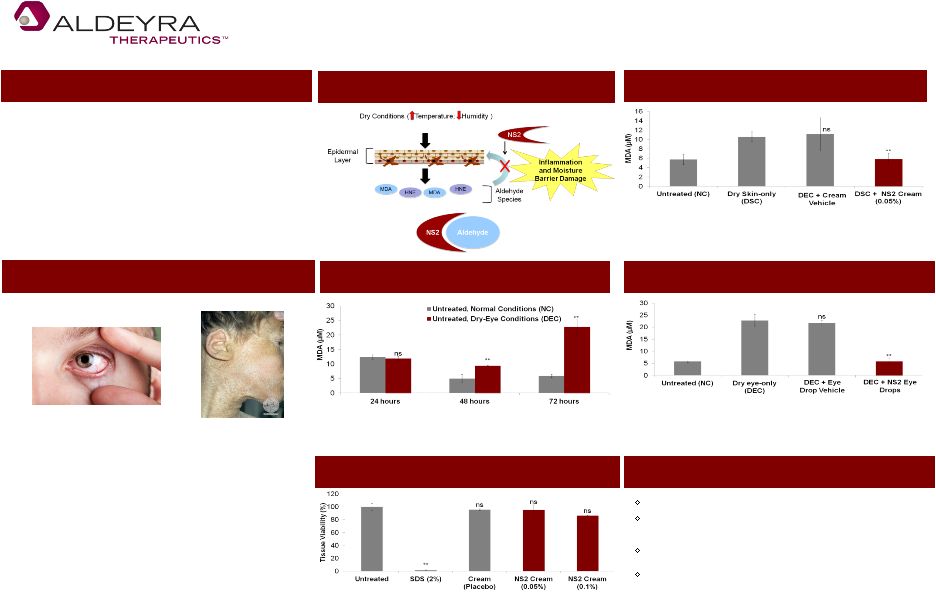Attached files
| file | filename |
|---|---|
| 8-K - 8-K - Aldeyra Therapeutics, Inc. | d722587d8k.htm |
| EX-99.2 - EX-99.2 - Aldeyra Therapeutics, Inc. | d722587dex992.htm |
 NS2, a
novel aldehyde trap, decreases aldehyde levels in dry skin and eye
models Scott L. Young
1
, Todd C. Brady
1
, Eduardo Perez
2
, Maxwell Stock
2
, Jose R. Fernandez
2
1
Aldeyra Therapeutics, Inc., Burlington, MA
2
Signum Dermalogix, Inc., Monmouth Junction, NJ
Dry
conditions
induce
aldehyde
generation
in
human
dermal
and
ocular
tissue.
Cream
placebo
used
for
NS2
active
formulations
and
NS2
creams
between
0.05-0.1%
are
unlikely
skin
irritants
when
topically
applied
twice
a
day
(12
hours
between
appli-
cation).
In
topical
dermatologic
and
eye
drop
formulations,
NS2
has
significant
aldehyde
trapping
activity
in
human
dermal
and
ocular
tissue
subjected
to
dry
conditions.
Topically
applied
NS2
could
be
a
safe
and
effective
treatment
for
diseases
characterized
by
dry
tissue.
Dry
environmental
conditions
(high
temperature,
low
humidity)
can
promote
lipid
oxidation
and
induce
elevated
levels
of
aldehyde
species
that
may
damage
lipid-rich
moisture
barriers
in
skin
and
eye,
generating
further
dryness.
Deficiencies
in
aldehyde
dehydrogenase
activity
in
Sjögren-
Larsson
Syndrome,
for
example,
may
lead
to
high
aldehyde
levels
and
damage
to
the
dermal
moisture
barrier
that
causes
the
severe
ichthyosis
characteristic
of
the
disease.
Since
patients
with
dry
eye
syndrome
manifest
elevated
aldehyde
levels
in
tears,
aldehydes
may
also
compromise
the
moisture
barrier
in
the
eye
and
thereby
exacerbate
dryness.
Thus,
lowering
aldehyde
levels
may
represent
a
novel
therapeutic
approach
for
treating
dryskinandeye conditions.
Fig 1. Dry skin and Dry eye conditions
Fig 4. NS2 cream formulations do not
affect viability of 3D skin models
NS2
cream
formulations
were
tested
for
skin
irritation
in
reconstructed
human
epidermis.
EpiDerm™
(MatTek®)
tissues
were
acclimated
for
24
hours
and
then
treated
topically
twice
(12
hours
apart)
with
NS2
cream
formulations
(0.05%
and
0.1%
w/v)
or
SDS
(2%
w/v),
used
as
positive
control.
Tissue
viability
levels
were
measured
by
the
MTT
reduction
assay
48
hours
after
treatments.
The
levels
of
tissue
viability
after
each
treatment
were
compared
to
the
untreated
group
to
estimate
the
potential
for
skin
irritation.
(**=
p<0.01)
SIG990
SIG990
SIG990
Abstract
Fig 5. NS2 prevents the increase in aldehyde
levels caused by dry conditions in skin tissue
Summary/Conclusions
Sjögren-Larsson Syndrome
Dry eye
In
a
topical
dermatologic
formulation,
NS2
(0.05%
w/v)
was
administered
to
reconstructed
human
epidermis
under
normal
and
dry
skin
conditions
(DSC).
EpiDerm™
(MatTek®)
tissues
were
acclimated
before
treatments
for
24
hours
and
then
treated
topically
with
or
without
NS2.
Tissues
were
incubated
under
normal
(37
°
C;
>40%RH)
or
DSC
(40
°
C;
<40%RH)
for
72
hours.
Malondialdehyde
(MDA)
levels
of
tissue
lysates
were
measured
using
the
TBARS
assay
and
compared
to
untreated
tissue.
(**
=
p<0.01).
Fig 3. Dry conditions increase aldehyde levels
in human tissue
EpiOcular™
(MatTek®)
tissues
were
acclimated
before
treatments
for
24
hours
and
then
incubated
under
normal
(37
°
C;
>40%RH)
or
dry-conditions
(40
°
C;
<40%RH)
for
24,
48
and
72
hours.
Malondialdehyde
(MDA)
levels
of
tissue
lysates
were
measured
using
the
TBARS
assay.
(ns
=non
significant;
**=
p<0.01)
Fig 6. NS2 prevents the increase in aldehyde
levels caused by dry conditions in ocular tissue
In
an
eye
drop
formulation,
NS2
(0.5%
w/v)
was
administered
to
reconstructed
human
cornea-like
tissue
under
normal
and
dry
eye
conditions
(DEC).
EpiOcular™
(MatTek®)
tissues
were
acclimated
before
treatments
for
24
hours
and
later
treated
topically
with
or
without
NS2.
Tissues
were
incubated
under
normal
(37
°
C;
>40%RH)
or
DEC
(40
°
C;
<40%RH)
for
72
hours.
Malondialdehyde
(MDA)
levels
of
tissue
lysates
were
measured
using
the
TBARS
assay
and
compared
to
untreated
tissue.
(**
=
p<0.01).
Fig 2. NS2: A novel aldehyde trap
Free
aldehydes
are
naturally
occurring
chemical
species
formed
during
a
variety
of
biological
processes,
including
polyamine
and
glucose
metabolism
and
lipid
peroxidation.
Uncontrolled
levels
of
aldehyde
species
can
lead
to
inflammation
via
activation
of
the
NF-Kß
pathway
and
also
damage
key
lipids
that
comprise
the
dermal
moisture
barrier
and
lubricate
the
surface
of
the
eye.
Elevated
levels
of
malondialdehyde
(MDA)
have
been
shown
in
a
variety
of
inflammatory
skin
and
eye
diseases,
including
psoriasis,
atopic
dermatitis,
anterior
uveitis,
and
rosacea.
In
addition,
high
levels
of
fatty
aldehydes
in
Sjögren-Larsson
Syndrome,
an
orphan
disease
caused
by
mutations
in
fatty
acid
aldehyde
dehydrogenase,
lead
to
severe
ichthyosis,
retinal
disease
and
neurological
disorders.
Here,
we
report
the
effect
of
dry
conditions
on
inducing
MDA
levels
in
human
skin
and
eye
tissue
and
the
activity
of
NS2,
a
novel
aldehyde-binding
small
molecule,
in
reducing
levels
of
MDA
generated
by
dry
conditions.
Topical
application
of
NS2
cream
to
three-dimensional
human
skin
equivalents
lowered
MDA
levels
(measured
by
TBARS
assay)
induced
by
dry
skin
conditions.
Moreover,
topical
application
of
NS2
eye
drops
to
three-dimensional
human
cornea-like
tissue
lowered
MDA
levels
induced
by
dry
eye
conditions.
These
results
suggest
that
NS2
could
mitigate
the
toxic
aldehyde
load
that
is
generated
in
dry
skin
and
dry
eye
conditions.
By
trapping
aldehydes,
NS2
may
protect
skin
and
eye
tissue
from
chronic
inflammation
caused
by
aldehydes
that
are
generated
in
dry
conditions,
and
in
addition
may
protect
lipids
that
are
critical
in
preserving
moisture
in
skin
and
eye.
Thus,
NS2
represents
a
potential
novel
compound
that
could
provide
a
dual
benefit
to
individuals
with
dry
skin
or
dry
eyes. |
